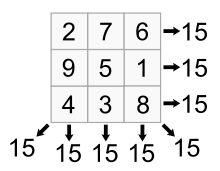An antimagic square of order n is an arrangement of the numbers 1 to n2 in a square, such that the sums of the n rows, the n columns and the two diagonals form a sequence of 2n + 2 consecutive integers. The smallest antimagic squares have order 4.[1]
Examples
Order 4 antimagic squares
| 2 |
15 |
5 |
13 |
| 16 |
3 |
7 |
12 |
| 9 |
8 |
14 |
1 |
| 6 |
4 |
11 |
10 |
|
| 1 |
13 |
3 |
12 |
| 15 |
9 |
4 |
10 |
| 7 |
2 |
16 |
8 |
| 14 |
6 |
11 |
5 |
|
Order 5 antimagic squares
| 5 |
8 |
20 |
9 |
22 |
| 19 |
23 |
13 |
10 |
2 |
| 21 |
6 |
3 |
15 |
25 |
| 11 |
18 |
7 |
24 |
1 |
| 12 |
14 |
17 |
4 |
16 |
|
| 21 |
18 |
6 |
17 |
4 |
| 7 |
3 |
13 |
16 |
24 |
| 5 |
20 |
23 |
11 |
1 |
| 15 |
8 |
19 |
2 |
25 |
| 14 |
12 |
9 |
22 |
10 |
|
Properties
In each of these two antimagic squares of order 4, the rows, columns and diagonals sum to ten different numbers in the range 29–38.[2] In the antimagic square of order 5 on the left, the rows, columns and diagonals sum up to numbers between 60 and 71.[2] In the antimagic square on the right, the rows, columns and diagonals add up to numbers between 59-70.[1]
Antimagic squares form a subset of heterosquares which simply have each row, column and diagonal sum different. They contrast with magic squares where each sum is the same.[2]
Open problems
- How many antimagic squares of a given order exist?
- Do antimagic squares exist for all orders greater than 3?
- Is there a simple proof that no antimagic square of order 3 exists?
Generalizations
A sparse antimagic square (SAM) is a square matrix of size n by n of nonnegative integers whose nonzero entries are the consecutive integers  for some
for some  , and whose row-sums and column-sums constitute a set of consecutive integers.[3] If the diagonals are included in the set of consecutive integers, the array is known as a sparse totally anti-magic square (STAM). Note that a STAM is not necessarily a SAM, and vice versa.
, and whose row-sums and column-sums constitute a set of consecutive integers.[3] If the diagonals are included in the set of consecutive integers, the array is known as a sparse totally anti-magic square (STAM). Note that a STAM is not necessarily a SAM, and vice versa.
References
- 1 2 Template:Cite 201 web
- 1 2 3 "Anti-magic Squares". www.magic-squares.net. Retrieved 2016-12-03.
- ↑ Gray, I. D.; MacDougall, J.A. (2006). "Sparse anti-magic squares and vertex-magic labelings of bipartite graphs". Discrete Mathematics. 306: 2878–2892. doi:10.1016/j.disc.2006.04.032.
|
|---|
| Types | | |
|---|
| Related shapes | |
|---|
| Concepts | |
|---|
| Higher dimensional shapes | |
|---|
| Related concepts | |
|---|
